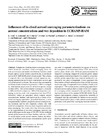Influences of in-cloud aerosol scavenging parameterizations on aerosol concentrations and wet deposition in ECHAM5-HAM
dc.contributor.author
Croft, Betty
dc.contributor.author
Lohmann, Ulrike
dc.contributor.author
Martin, Randall V.
dc.contributor.author
Stier, Philip
dc.contributor.author
Wurzler, Sabine
dc.contributor.author
Feichter, Johann
dc.contributor.author
Hoose, C.
dc.contributor.author
Heikkilä, Ulla
dc.contributor.author
Van Donkelaar, Aaron
dc.contributor.author
Ferrachat, Sylvaine
dc.date.accessioned
2019-09-05T12:27:49Z
dc.date.available
2017-06-08T22:23:30Z
dc.date.available
2019-09-05T12:27:49Z
dc.date.issued
2010
dc.identifier.issn
1680-7324
dc.identifier.issn
1680-7375
dc.identifier.other
10.5194/acp-10-1511-2010
en_US
dc.identifier.uri
http://hdl.handle.net/20.500.11850/17102
dc.identifier.doi
10.3929/ethz-b-000017102
dc.description.abstract
A diagnostic cloud nucleation scavenging scheme, which determines stratiform cloud scavenging ratios for both aerosol mass and number distributions, based on cloud droplet, and ice crystal number concentrations, is introduced into the ECHAM5-HAM global climate model. This scheme is coupled with a size-dependent in-cloud impaction scavenging parameterization for both cloud droplet-aerosol, and ice crystal-aerosol collisions. The aerosol mass scavenged in stratiform clouds is found to be primarily (>90%) scavenged by cloud nucleation processes for all aerosol species, except for dust (50%). The aerosol number scavenged is primarily (>90%) attributed to impaction. 99% of this impaction scavenging occurs in clouds with temperatures less than 273 K. Sensitivity studies are presented, which compare aerosol concentrations, burdens, and deposition for a variety of in-cloud scavenging approaches: prescribed fractions, a more computationally expensive prognostic aerosol cloud processing treatment, and the new diagnostic scheme, also with modified assumptions about in-cloud impaction and nucleation scavenging. Our results show that while uncertainties in the representation of in-cloud scavenging processes can lead to differences in the range of 20–30% for the predicted annual, global mean aerosol mass burdens, and near to 50% for accumulation mode aerosol number burden, the differences in predicted aerosol mass concentrations can be up to one order of magnitude, particularly for regions of the middle troposphere with temperatures below 273 K where mixed and ice phase clouds exist. Different parameterizations for impaction scavenging changed the predicted global, annual mean number removal attributed to ice clouds by seven-fold, and the global, annual dust mass removal attributed to impaction by two orders of magnitude. Closer agreement with observations of black carbon profiles from aircraft (increases near to one order of magnitude for mixed phase clouds), mid-troposphere 210Pb vertical profiles, and the geographic distribution of aerosol optical depth is found for the new diagnostic scavenging scheme compared to the prescribed scavenging fraction scheme of the standard ECHAM5-HAM. The diagnostic and prognostic schemes represent the variability of scavenged fractions particularly for submicron size aerosols, and for mixed and ice phase clouds, and are recommended in preference to the prescribed scavenging fractions method.
en_US
dc.format
application/pdf
en_US
dc.language.iso
en
en_US
dc.publisher
Copernicus
dc.rights.uri
http://creativecommons.org/licenses/by/3.0/
dc.title
Influences of in-cloud aerosol scavenging parameterizations on aerosol concentrations and wet deposition in ECHAM5-HAM
en_US
dc.type
Journal Article
dc.rights.license
Creative Commons Attribution 3.0 Unported
dc.date.published
2010-02-15
ethz.journal.title
Atmospheric Chemistry and Physics
ethz.journal.volume
10
en_US
ethz.journal.issue
4
en_US
ethz.journal.abbreviated
Atmos. Chem. Phys.
ethz.pages.start
1511
en_US
ethz.pages.end
1543
en_US
ethz.version.deposit
publishedVersion
en_US
ethz.identifier.wos
ethz.identifier.nebis
004294181
ethz.publication.place
Göttingen
ethz.publication.status
published
en_US
ethz.leitzahl
ETH Zürich::00002 - ETH Zürich::00012 - Lehre und Forschung::00007 - Departemente::02350 - Dep. Umweltsystemwissenschaften / Dep. of Environmental Systems Science::02717 - Institut für Atmosphäre und Klima / Inst. Atmospheric and Climate Science::03690 - Lohmann, Ulrike / Lohmann, Ulrike
en_US
ethz.leitzahl.certified
ETH Zürich::00002 - ETH Zürich::00012 - Lehre und Forschung::00007 - Departemente::02350 - Dep. Umweltsystemwissenschaften / Dep. of Environmental Systems Science::02717 - Institut für Atmosphäre und Klima / Inst. Atmospheric and Climate Science::03690 - Lohmann, Ulrike / Lohmann, Ulrike
ethz.relation.isNewVersionOf
10.3929/ethz-b-000157044
ethz.date.deposited
2017-06-08T22:23:33Z
ethz.source
ECIT
ethz.identifier.importid
imp59364c725d02712029
ethz.ecitpid
pub:29052
ethz.eth
yes
en_US
ethz.availability
Open access
en_US
ethz.rosetta.installDate
2017-07-20T16:55:08Z
ethz.rosetta.lastUpdated
2024-02-02T09:17:45Z
ethz.rosetta.exportRequired
true
ethz.rosetta.versionExported
true
ethz.COinS
ctx_ver=Z39.88-2004&rft_val_fmt=info:ofi/fmt:kev:mtx:journal&rft.atitle=Influences%20of%20in-cloud%20aerosol%20scavenging%20parameterizations%20on%20aerosol%20concentrations%20and%20wet%20deposition%20in%20ECHAM5-HAM&rft.jtitle=Atmospheric%20Chemistry%20and%20Physics&rft.date=2010&rft.volume=10&rft.issue=4&rft.spage=1511&rft.epage=1543&rft.issn=1680-7324&1680-7375&rft.au=Croft,%20Betty&Lohmann,%20Ulrike&Martin,%20Randall%20V.&Stier,%20Philip&Wurzler,%20Sabine&rft.genre=article&rft_id=info:doi/10.5194/acp-10-1511-2010&
Files in this item
Publication type
-
Journal Article [130586]

